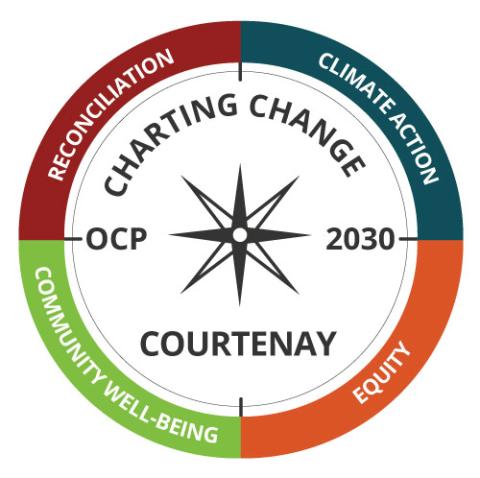The City is reviewing the Official Community Plan (OCP) to meet new provincial housing rules. Learn more and share your input on the City's Engage Comox Valley page for the OCP.
The Courtenay Official Community (OCP) Plan Bylaw 3070 was adopted on July 25, 2022.
View the Official Community Plan [PDF/35.1MB]
View the Official Community Plan (flippingbook)
In 2024, the Province introduced new legislation requiring local governments regularly review and update their OCPs. The goal is to make sure there is enough land to meet the community’s five- and 20-year housing needs projections, as identified through the housing needs report [PDF/738KB].
What is the OCP
The OCP is a long-term vision for Courtenay. It guides decisions on land use, housing, transportation, infrastructure and more.
The OCP ensures that new developments and City services align with the community’s priorities. It applies to the entire municipality and helps Council make decisions on:
- growth and land use
- streets and transportation
- affordable housing
- the natural environment
- parks and recreation
- arts, culture and heritage
- food systems
- economic development
The OCP is built around four core directions, as symbolized by the compass:
- reconciliation
- community well-being
- equity
- climate action
Local area plans
Local area plans provide detailed guidance for specific parts of the city. Currently, the OCP includes the Arden Corridor Local Area Plan [PDF/4.6MB].
Courtenay’s OCP is symbolized by a compass which identifies the four core directions of the plan: reconciliation, community well-being, equity, and climate action. These core directions are reflected in the hundreds of policies contained throughout the plan.
OCP maps
Development guidelines and permits
If you are planning a new development, review the Development Standards Policies Reference Guide [PDF/314KB].
Some projects need a development permit. This applies to:
- large buildings
- infill residential development
- areas near environmentally sensitive lands, steep slopes or farms
Development permits regulate form and character, signage, siting, landscaping, screening, lighting and parking. The OCP designates these areas, but guidelines are now part of Zoning Bylaw No. 2500.
Learn more about development permits.
Applying for an OCP amendment
An OCP amendment application is required when a proposed development does not align with the objectives and policies in the OCP or does not match its land use designation(s).
OCP amendments are rare and are usually submitted with a zoning amendment application, following a similar process.
A public hearing is always required.
View the Zoning Bylaw page for instructions and to access the application form.

